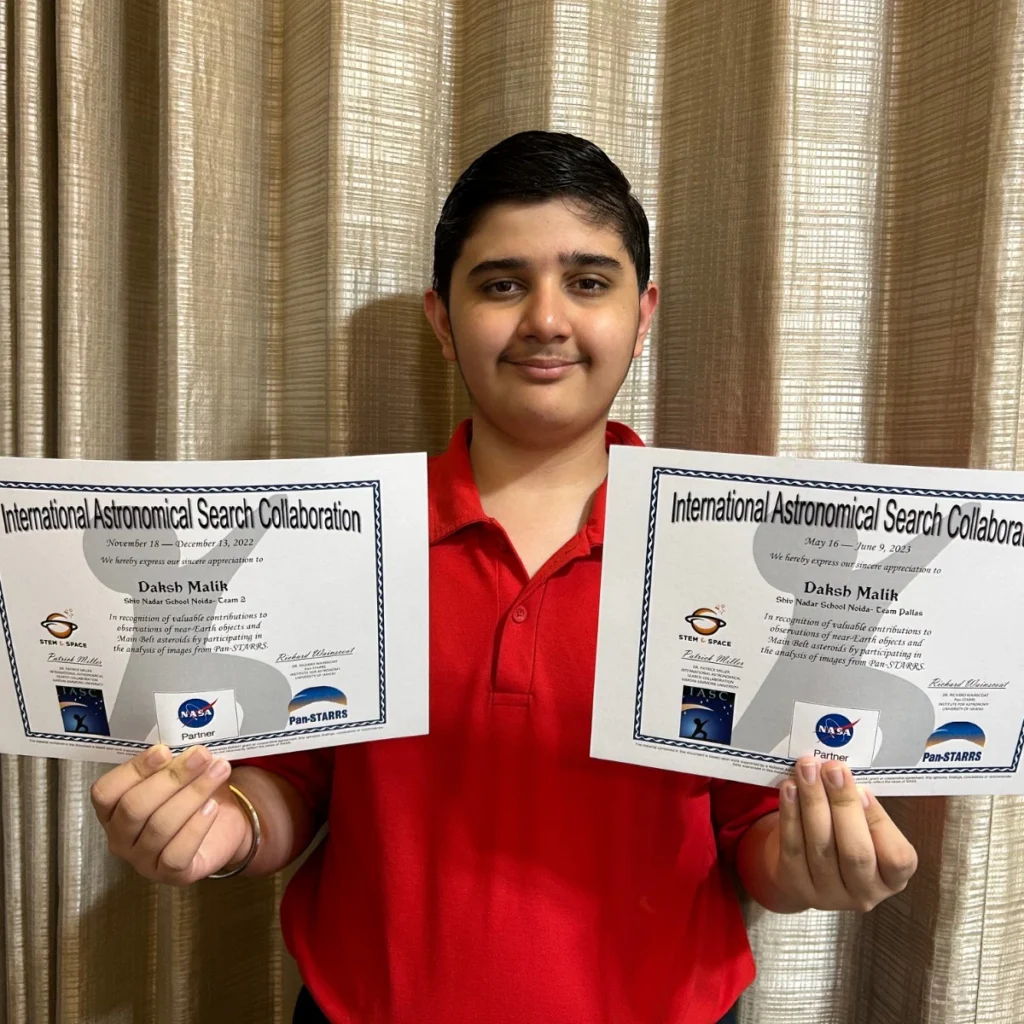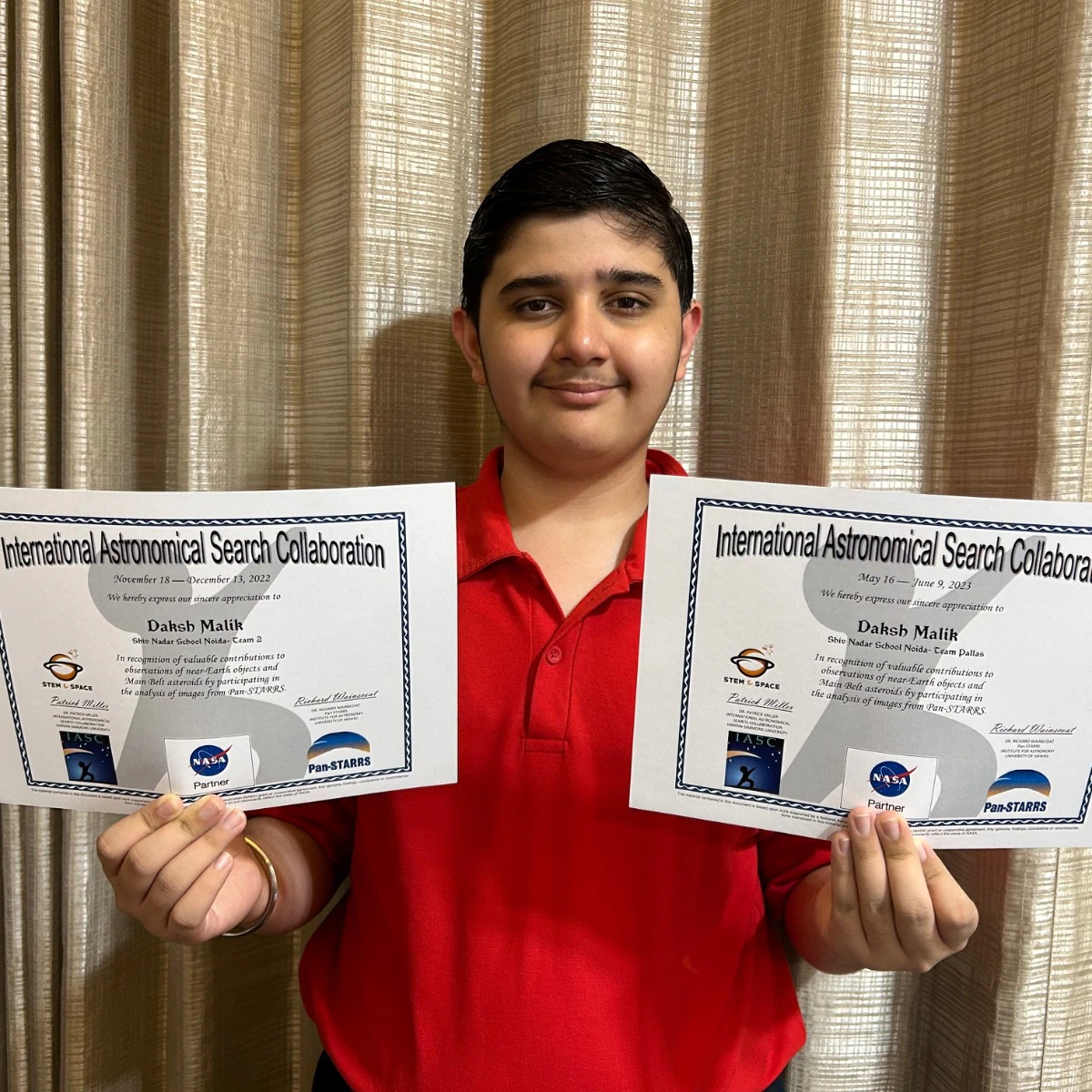
In Short
- Noida student of Class 9 discovers asteroid with NASA programme
- 2023 OG40 will soon be renamed by 14-year-old Daksh Malik
- Shiv Nadar School’s astronomy club sparked his space interest
In a remarkable feat of young scientific achievement, 14-year-old Daksh Malik, a student from Shiv Nadar School in Noida, India, has made an extraordinary contribution to space exploration. Daksh discovered an asteroid located between Mars and Jupiter, a finding that has captured the attention of the scientific community worldwide. His discovery was part of NASA’s International Asteroid Discovery Project (IADP), a program that allows students and the public to participate in discovering asteroids using NASA’s advanced software and data. This asteroid, currently identified as ‘2023 OG40’, was first noticed by Daksh in 2023, and after a thorough verification process, NASA officially confirmed it as a “Provisional Discovery of a Main Belt Asteroid.”
Daksh’s journey into the world of space exploration began long before he ever spotted the asteroid. Fascinated by space and celestial bodies from a young age, Daksh has been captivated by space documentaries and the mysteries of the universe since he was little. His passion for space only grew stronger over the years, which eventually led him to seek out opportunities to participate in real scientific projects that allow him to engage directly with astronomy. This curiosity and drive to explore the cosmos led him to join NASA’s Citizen Science program, a platform designed to democratize space exploration and make it accessible to students and everyday people around the world.
Also Read:Urgent Warning for Chrome Users
The IADP is a key initiative in this effort, a collaboration between NASA’s Citizen Science Project, the International Astronomy Search Collaboration (IASC), and Pan-STARRS, an astronomical survey in Hawaii. The program allows participants to use NASA’s software and tools to analyze images captured by telescopes and search for asteroids or other important objects in space. Each year, over 6,500 people from more than 80 countries take part in this global project. However, only a few participants successfully discover an asteroid, making Daksh’s achievement all the more remarkable.
Daksh, along with two of his classmates, spent approximately a year and a half searching for asteroids as part of the IADP. The trio was guided by Dr. Patrick Miller, an astronomy expert from Hardin Simmons University. Daksh, with the support of his classmates and Dr. Miller, combed through images from the Pan-STARRS telescope, which provided high-resolution photographs of objects in space. They were searching for asteroids—rocky bodies that orbit the Sun, most of which are located in the asteroid belt between Mars and Jupiter. Their task was to spot any new, undiscovered asteroids in these images.
It was during this search that Daksh made his groundbreaking discovery. After six preliminary detections of asteroids, Daksh’s keen observation and careful analysis led to the identification of what would eventually be confirmed as 2023 OG40. This asteroid’s discovery has placed Daksh among an exclusive group of young astronomers: just five other Indian students have ever discovered an asteroid through such programs. This prestigious accomplishment highlights the impact that student participation in citizen science can have on advancing our knowledge of the universe.
Following Daksh’s initial detection, the asteroid underwent further verification by NASA. The process of confirming an asteroid is a meticulous one that takes years to complete. After the first identification, NASA conducted additional observations to track the asteroid’s movement and ensure its discovery was accurate. Once the data was analyzed, the Minor Planet Centre (MPC) granted the asteroid provisional status, marking it as a significant find. This provisional status is the first step in the formal process of confirming the asteroid and adding it to the global record. Once fully verified, the asteroid will be officially recognized by the International Astronomical Union (IAU), based in Paris, and Daksh will be given the honor of naming it.
Naming the asteroid is one of the most exciting aspects of Daksh’s discovery, and he has already started to think about what name he might choose. While he has not yet made a final decision, Daksh has shared that two potential names he is considering are “Destroyer of the World” and “Countdown.” Both names reflect his deep interest in space and its vast, sometimes mysterious, nature. However, the naming process will take time, as it is part of the final verification stage, which could last anywhere from four to five years. Once all steps are complete, Daksh will have the unique opportunity to give this asteroid a permanent name, forever linking his legacy to this celestial body.
While Daksh’s discovery is a personal achievement, it also highlights the invaluable role that educational institutions, mentorship, and collaborative programs play in shaping young minds. Daksh credited his success to the support he received from his school’s observatory, the astronomy programs, and his teachers, who fostered his interest in space and encouraged him to pursue his dreams. His discovery has been a source of pride for Shiv Nadar School, and it demonstrates the importance of extracurricular programs in providing students with opportunities to explore their passions and contribute to global scientific efforts.
The experience has also been transformative for Daksh himself. Reflecting on his journey, he has expressed how discovering an asteroid felt like a dream come true. It has inspired him to set even higher goals for himself and reinforced his belief in the importance of perseverance and dedication. Daksh’s success is a reminder that with hard work, curiosity, and the right resources, anyone—regardless of age—can make a significant contribution to science. His hope is that his story will encourage other students, especially those with an interest in science and astronomy, to dream big and pursue their passions without fear.
In the broader context, Daksh’s discovery is part of a growing trend where citizen science projects allow the public to participate in real scientific research. These programs not only contribute to major discoveries, but they also inspire a new generation of scientists. Daksh is now one of many young people who have made their mark on space exploration, proving that the sky is not the limit but rather the beginning.
In the years to come, Daksh’s name will be forever associated with 2023 OG40, and his discovery will serve as a testament to the power of curiosity and the potential of young minds. His achievement is a shining example of how programs like NASA’s Citizen Science initiative can inspire students to engage with science in meaningful ways and make a lasting impact on the world.
